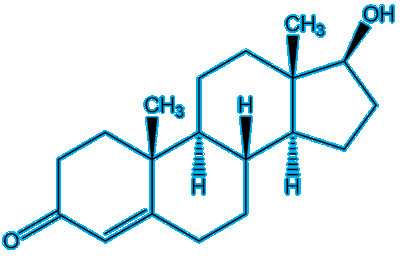
Testosterone
![]()
Testosterone
The male hormone
![]()
Simon Cotton
University of Birmingham
![]()
Molecule of the Month August 2019
Also available: HTML version.
![]()

Testosterone builds muscles and makes men aggressive
- but it doesn't turn them green!
 Testosterone |
TestosteroneThe male hormone
Simon Cotton
Molecule of the Month August 2019
|
 Testosterone builds muscles and makes men aggressive - but it doesn't turn them green! |
It’s a male molecule, yes?It is actually found in both men and women. Usually there is more of it in men, though it is possible for a woman to have a higher level of testosterone than a particular man. After the South African athlete Caster Semenya (photo, right) won the 800-metres race at the 2009 World Championships in Berlin, she was barred from competing for a year and had to undergo tests. It was said that her testosterone levels were three times those of an average woman, though still below male levels. This is known as 'hyperandrogenism' and has been claimed to confer an advantage over female athletes with lower testosterone levels, though this view has been challenged. On May 1st 2019 it was reported that the International Association of Athletics Federations (IAAF), which is the international governing body for the athletics, require that Semenya, a double Olympic 800m champion, and other athletes in the same position, will need to take testosterone-lowering medications to bring their testosterone levels down to those of other female athletes. Why is testosterone associated with 'male-ness'?It’s associated with noticeable changes in males at puberty, such as deepening of the voice, increase in muscles, changes in sexual development and growth of hair. |
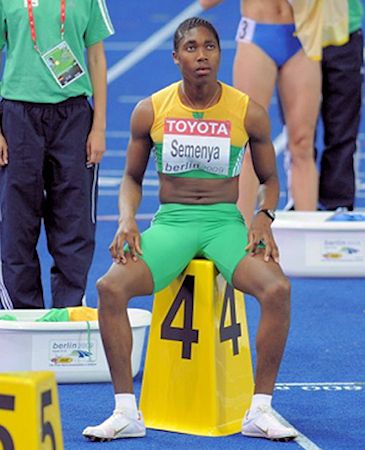 Caster Semenya during the World Athletics Championships in 2009. Photo: Erik van Leeuwen [GFDL] via Wikimedia Commons |
The body makes it in the male testes from cholesterol (see March 2014 MOTM) in a reaction with several stages and involving a number of enzymes. The most obvious change is the removal of the long eight-carbon side-chain of the parent cholesterol molecule. Six carbons are removed by an enzyme, leading to progesterone, and another enzyme removes two more.
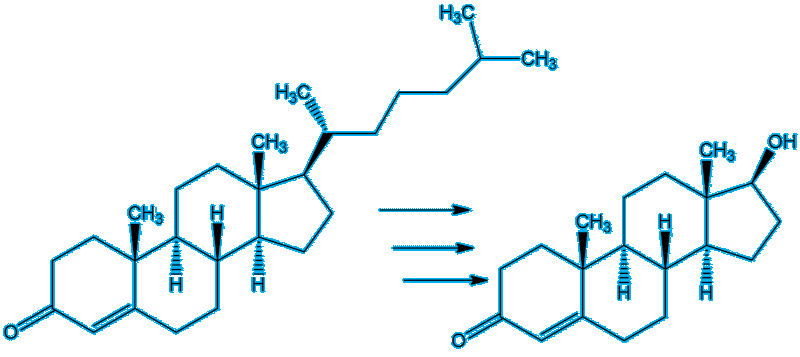 |
|
| Cholesterol | Testosterone |
Outside the body, testosterone was actually first isolated in 1927 from bull’s testes. The first chemists to synthesise it, Adolf Butenandt and Leopold Ruzicka, shared the Nobel Prize in chemistry in 1939.
Compare the structure of testosterone with the two most important female hormones, estradiol and progesterone (see MOTM on Estradiol), and you’ll see how small changes in structure can have a big effect upon bodily function.
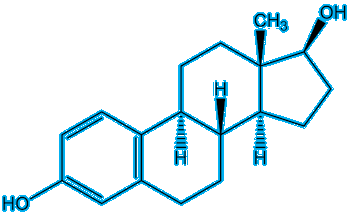 |
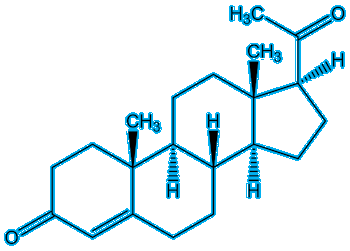 |
| Estradiol | Progesterone |
Originally, testosterone and its ester derivatives were used medicinally. By restoring a sick patient’s testosterone levels, it speeded up the recovery of their muscles. Esters were first made in the 1930s and are widely used and abused by bodybuilders and sportsmen. One of the most widely used is testosterone enanthate.
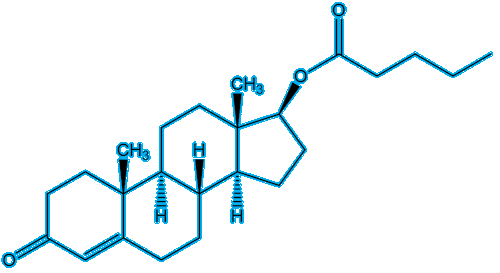 |
|
| Testosterone enanthate |
Do other animals use testosterone?Yes, most spectacularly in Asian bull elephants. Their testosterone levels can increase by a factor of 60-fold in the periodic condition called musth. This is hormonally induced, but no one understands why. During this time the male elephants become very aggressive, and can go on a mating frenzy with any female elephants in season. They have also been known to kill female elephants that aren’t in season! Rather than simply a feature of mating, another suggestion is that musth is connected with the reorganisation of dominance amongst males in elephant herds. |
 Male elephants in musth become aggressive and fight other males for dominance. |
 Synthetic testosterone Note the warning on the label which says that Federal Law prohibits dispensing without prescription. Photo: Wikimedia Commons |
How does testosterone work?At the molecular level, testosterone plugs into what is known as the 'androgen receptor' and is able to move into the cell nucleus, where it binds to DNA. Here, it affects genes that are responsible for making protein, and it is this that leads to the build up of muscular tissue. Why do athletes take testosterone and similar steroids?Testosterone was the first anabolic steroid used by athletes to improve performance, and continues to be so used. In the early 1950s, American weightlifters suspected that their Russian opponents were using testosterone and started using it, usually as esters, followed by synthetic anabolic steroids. Athletes have taken testosterone by injection, by oral routes or by absorption through the skin (e.g. transdermal patches). By building up muscles which repair faster, the athletes improve the level of their performance and also their recovery time. It was estimated that in 1968 one third of the US track and field team for the Mexico City Olympics were using steroids at their pre-games training camp. Steroid testing at the Olympics was not introduced until the 1976 Montreal Games, which was a bit too late as athletes had been using synthetic derivatives of testosterone, such as Dianabol since the late 1950’s (see the August 2010 MOTM about THG). And taking testosterone is safe?Sadly, no. The most obvious symptom of testosterone abuse is that the male testes shrink, as they aren’t needed to make testosterone any more. Health problems associated with high levels of steroid abuse include liver and kidney tumours, psychiatric disorder, and heart problems. There are also claims that taking synthetic testosterone and other anaboloc steroids make users overly aggressive and angry - so-called 'roid rage! |
Testosterone has an inactive isomer called epitestosterone, which differ in only one stereogenic centre – the OH group. Testosterone is the S-isomer and epitestosterone is the R-isomer. In most people they occur in an approximate 1:1 ratio, however epitestosterone has no anabolic effects.
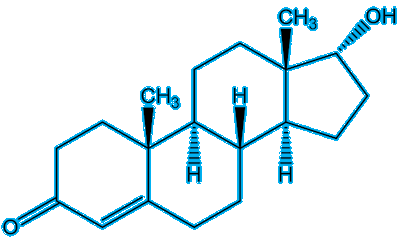 |
|
| Epitestosterone |
Testers in sport look at the relative amounts of testosterone and epitestosterone. In 1982, the International Olympic Commission (IOC) decided that, from 1982, a 6:1 ratio would result in immediate disqualification. The rule now says that if the ratio is above 4:1, additional samples must be tested.
Of course, drug cheats can try to get around this by using synthetic epitestosterone as a “masking agent”, by taking that as a mixture with testosterone, so that the T:E ratio is low enough not to be suspect. But drug testers have a further weapon in their armoury. ‘Temperate-zone’ plants operate by a C4 biosynthetic pathway, whilst tropical plants use a C3 photosynthetic route. Synthetic testosterone is usually made from C3 plants, like wild yams or soy, whilst human testosterone is derived from a diet that mixes C3 and C4 plants. So testers therefore can carry out a carbon isotope ratio (CIR) test, measuring the ratio of 13C to 12C isotopes in the testosterone sample, to distinguish between natural and synthetic testosterone.
And sportsmen have been caught?One of the best-known people to fall victim to the testing was the American cyclist Floyd Landis. Coming to Stage 16 of the 2006 Tour de France, Landis led the field, but that day he dropped right back, losing eight minutes. However, the next day Landis destroyed the field and as a result of the comeback went on to finish first in Paris. When a sample taken after Stage 17 was tested, apparently a very high T:E ratio (reportedly 11:1) was detected and it is also reported that he had failed the carbon-isotope-ratio test. Landis has admitted using performance-enhancing drugs for much of his career, but denies using testosterone or other drugs on the 2006 Tour. The “best” excuse is that of Dennis Mitchell, a member of the gold-medal-winning US team in the 4×100-metres relay at the 1992 Barcelona Olympic Games. In a test six years later, his sample proved positive for testosterone. He said that he’d had "five bottles of beer, and sex with his wife at least four times ... it was her birthday, the lady deserved a treat". This impressed the public, but not the authorities, who banned him for two years. |
 Floyd Landis in the Tour of California 2006. Photo: Michael David Murphy, CC BY-SA 2.0, via Wikimedia Commons |
The jury is out on this. Some studies – but not all – have indicated that steroid abuse does have a link with aggressiveness. Remember the elephants! As Dr David Banner (the Hulk's alter ego) once said, "Don't make me angry, you wouldn't like me when I'm angry!"
![]()
![]()
![]() Back to Molecule of the Month page. [DOI:10.6084/m9.figshare.7649273]
Back to Molecule of the Month page. [DOI:10.6084/m9.figshare.7649273]